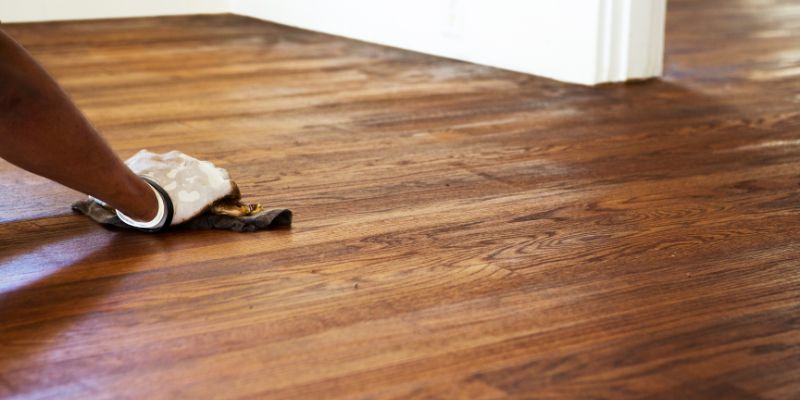To refinish wood furniture without sanding, you can use a chemical stripper to remove the existing finish and then apply a new stain or paint. This method allows you to achieve a smooth and refreshed look without the hassle of sanding.
Refinishing wood furniture without sanding is an effective way to breathe new life into your old pieces. Whether you want to update the color or revive the natural beauty of the wood, this method can save you time and effort.
By using a chemical stripper, you can easily remove the existing finish, making it easier to apply a new coat of stain or paint. This process can help you achieve a professional-looking result without the need for extensive sanding. By following this approach, you can transform your worn-out furniture into stunning showcase pieces for your home.
Understanding The Basics Of No-sand Refinishing
Refinishing wood furniture can be a rewarding process, but traditional sanding methods can be time-consuming and messy. However, there are ways to achieve a beautifully refinished piece without the need for extensive sanding. With the right approach and tools, it’s possible to breathe new life into your wooden furniture while saving time and effort.

Importance Of Proper Preparation For Refinishing Wood
Before diving into the no-sand refinishing process, it’s crucial to emphasize the importance of proper preparation. Cleaning the surface to remove dirt, grime, and old finishes is essential for the success of this technique. Additionally, ensuring the wood is in good condition and free of any major damages is important before starting the refinishing process.
Overview Of Tools And Materials Needed
When opting for a no-sand refinishing approach, you will need a set of specific tools and materials. Key items include a deglosser or liquid sandpaper, quality paint or stain, a paintbrush or foam brush, and a topcoat for protection. Utilizing these tools and materials effectively is integral to achieving a professional-looking finish.
Brief Comparison Between Traditional Sanding And No-sand Techniques
Comparing traditional sanding methods with no-sand techniques highlights the time-saving and convenience benefits of the latter approach. While sanding may be necessary for heavily damaged or weathered surfaces, newer finishes or light to moderate wear can often be revitalized through no-sand refinishing. This method not only saves time but also minimizes the mess and dust associated with traditional sanding.
Choosing The Right Chemical Stripper
When it comes to refinishing wood furniture without sanding, choosing the right chemical stripper is crucial. Chemical strippers are highly effective for removing old paint or finish from wood surfaces, allowing you to refinish the furniture without the labor-intensive process of sanding. In this section, we’ll explore the various types of chemical strippers suitable for wood furniture, how to apply them effectively, and the necessary safety precautions.
Types Of Chemical Strippers Suitable For Wood Furniture
There are several types of chemical strippers available, each catering to specific needs and preferences. Here’s a brief overview of the most common types:
| Type | Description |
|---|---|
| Methylene Chloride-based strippers | Effective for removing multiple layers of paint or finish. Extremely potent, requiring careful handling. |
| Citrus-based strippers | Environmentally friendly and safer to use. Suitable for light to medium paint or finish removal. |
| Paste strippers | Ideal for vertical surfaces, as they cling to the wood without dripping. Can be effective for intricate details. |
How To Apply Chemical Stripper Effectively
Proper application of chemical stripper is essential for achieving the best results. Follow these steps for effective application:
- Prepare the work area by covering nearby surfaces with a tarp or plastic sheet.
- Apply the chemical stripper using a brush, ensuring even coverage over the entire surface.
- Allow the stripper to sit for the recommended time, as specified on the product’s label.
- Use a scraping tool to gently remove the softened paint or finish, working in the direction of the wood grain.
- Clean the wood surface thoroughly with mineral spirits or a similar solvent to remove any remaining residue.
Safety Precautions While Using Chemical Strippers
Using chemical strippers requires careful attention to safety to minimize potential health risks. Consider the following safety precautions:
- Work in a well-ventilated area to avoid inhaling fumes.
- Wear protective gloves, safety goggles, and a respirator to prevent skin contact and inhalation of chemical vapors.
- Dispose of used chemical stripper and residue properly, following local disposal guidelines.
Preparing Your Furniture For No-sand Refinishing
Cleaning The Wood Surface Thoroughly
Before beginning the refinishing process, it’s essential to thoroughly clean the wood surface. Use a mild detergent and warm water to remove any dirt, grime, or grease that may have accumulated on the furniture. Use a soft-bristled brush or sponge to gently scrub the surface, taking care to avoid scratching the wood.
Repairing Minor Scratches And Dents
Inspect the furniture for any minor scratches or dents. Use a wood filler to fill in any imperfections in the surface. After applying the filler, allow it to dry completely before sanding it down with a fine-grit sandpaper until the surface is smooth and even.
How To Apply And Remove Chemical Stripper
When using a chemical stripper to remove the existing finish, ensure that you are working in a well-ventilated area. Apply the stripper according to the manufacturer’s instructions, using a brush or cloth to evenly coat the surface. Wait for the specified time for the chemical to work and then use a scraper to gently remove the old finish, being careful not to damage the wood underneath.
Applying The New Finish Flawlessly
When it comes to refinishing wood furniture without sanding, the most crucial step is applying the new finish flawlessly. Whether you’re opting for a paint or stain, achieving a smooth, professional look is essential for revitalizing your furniture without the hassle of sanding. In this section, we’ll explore the selection of paints and stains for no-sand finishing, techniques for even application of the new finish, and tips for achieving a flawless result.
Selection Of Paints And Stains For No-sand Finishing
When refinishing wood furniture without sanding, the choice of paint or stain plays a significant role in the outcome. Opt for latex or chalk paint for a seamless finish without the need for sanding. These types of paints adhere well to the surface and can effectively cover imperfections. On the other hand, for staining without sanding, look for gel stains as they are designed to be applied over existing finishes without the necessity of sanding.
Techniques For Even Application Of The New Finish
To ensure an even application of the new finish, it’s essential to clean the surface thoroughly before applying the paint or stain. Use a quality brush or foam roller for an even and consistent coat. Apply the paint or stain in thin, smooth layers, working in the direction of the wood grain. This technique helps to prevent drips and uneven coverage, resulting in a professional-looking finish.
Tips For Achieving A Smooth, Professional Look Without Sanding
- Lightly sand any rough areas: While the overall process is no-sand, it’s beneficial to lightly sand any rough spots or imperfections before applying the new finish. This ensures a smoother surface for the paint or stain to adhere to.
- Use a high-quality sealer: Once the new finish is applied, consider using a high-quality polyurethane sealer for added protection and a polished look. This further enhances the durability and appearance of the refinished furniture.
- Work in a well-ventilated area: Proper ventilation is crucial during the application process. This not only aids in the drying of the finish but also ensures a more comfortable and safer environment for the refinishing project.
Maintaining Your Refinished Piece
After successfully refinishing your wood furniture without sanding, it’s essential to maintain the newly-restored appearance and protect it from wear and tear. Here are some important tips for preserving your refinished piece:
Advice On Curing And Drying Times
Once you have completed the refinishing process, it is crucial to allow adequate curing and drying time for the new finish to fully set and harden. Follow the recommended curing time specified by the finish manufacturer to ensure that the surface achieves maximum durability. This will help prevent premature scratching or damage to the refinished piece.
Best Practices For Preserving The New Finish
To maintain the longevity of the refinished wood furniture, it is important to adhere to best practices for preserving the new finish. Avoid placing hot items directly on the surface and use coasters or mats to protect it from moisture, heat, and scratches. Regularly dust and clean the furniture using a soft, damp cloth to prevent the buildup of dirt and grime that can compromise the finish.
Regular Care Routine For Extended Durability
Establishing a regular care routine is essential for extending the durability of the refinished piece. This includes periodic inspection for any signs of wear or damage, as well as timely touch-ups and maintenance as needed. Additionally, avoiding exposure to direct sunlight can help prevent fading and discoloration of the new finish, ensuring its long-lasting beauty.
Frequently Asked Questions Of How To Refinish Wood Furniture Without Sanding
How To Refinish Furniture Without Sanding?
To refinish furniture without sanding, use a liquid deglosser to remove the existing finish. Clean the piece thoroughly, then apply a bonding primer. Finally, finish with a topcoat. This process saves time and effort while still achieving a smooth, professional look.
What Is An Alternative To Sanding Wood Furniture?
An alternative to sanding wood furniture is using chemical strippers or heat guns to remove old finish. These methods can help refurbish the furniture without the need for sanding.
Can You Paint Over Stained Wood Without Sanding?
Yes, you can paint over stained wood without sanding by using a primer specifically designed for adhesion. Choose a high-quality paint and apply thin, even coats for the best results.
How Do You Restore Weathered Wood Furniture?
To restore weathered wood furniture, sand the surface, apply wood cleaner, and let it dry. Use wood stain or paint to enhance the color and protect the surface. Finish with a sealant for added protection and shine. Regular maintenance will prolong the furniture’s lifespan.
Conclusion
In short, refinishing wood furniture without sanding can be a simple and rewarding DIY project. By following the steps outlined in this guide, you can breathe new life into old furniture pieces and create a polished, professional finish without the hassle of sanding.
With some patience and the right technique, you can achieve stunning results and transform your space.



2 thoughts on “How to Refinish Wood Furniture Without Sanding: Easy and Effective Techniques”